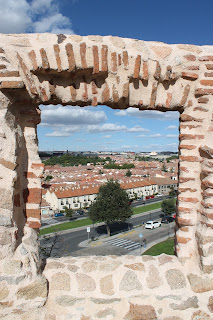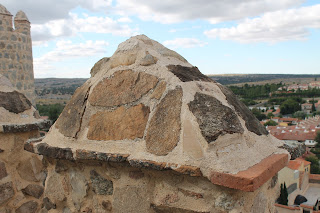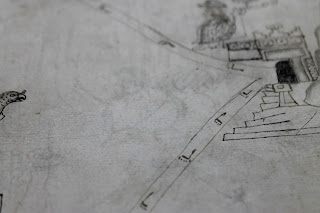47 years ago, as a young man of 21, I took an unforgettable 4 day bus trip along the Mediterranean coast from Rome, having just finished my first year of Philosophy there, up to Torino and on to the Italian Alps, then across the French Provence, across the border at Biarritz, down into Spain at San Sabastian, past Burgos, and on to Salamanca, where I would take a 30 day retreat, modeled after the Spiritual Exercises of Ignatius of Loyola..
Our routine each week during the Spiritual Exercises was 6 days of silence, with Mass, prayer and meditation, while on the 7th day, we had an outing, and the best part, we were allowed to break silence. I was with a group of some 100 seminarians, most of us in our 20's. The 30 day retreat is a rigorous spiritual experience intended only to be carried out a few times during the lifetime of a seminarian or a religious.
Our outings were a welcome respite from hours of prayer, silence and meditation. One outing was to get to know our host city of Salamanca. Another outing took us to Toledo. The roads of Spain back in the early 1970's were nothing like the modern toll ways we use today. The roads were narrow, dangerous, full of potholes, with only one lane coming and another going back. Herds of sheep and goats crossing the road, seemingly always around a tight curve. Passing the truck in front, always seemed a life-endangering episode. On our long drive back from Toledo, at sunset, we saw a magnificent walled city, gleaming gold in the dying beams of dusk. It was the first and only time I had seen Avila.
We didn't get the chance to visit it, or even enter it. I have yearned ever since to come back and explore this city of mystics. On Saturday 9th, 2017, Estela and I finally fulfilled this dream.
But there is much more to this dream than to see the gleaming walls of a fortified city. There is much more to this city than mere walls. And there is much more to this pilgrimage than Avila.
Let me try to situate Avila in its proper context. It was a an hour and 15 minute drive (75 miles), due west, from the Madrid's Barajas International Airport. Avila is part of Castile, the epicenter of Spain, historically, culturally and geographically. Avila with its arid steppes, are part of the heartland of Spain.
In and around Avila, we can see the evidence of a Roman Castrum or settlement. But Avila as we see it today was born in the IXth Century. In the IXth to the XVth centuries, it was frequently attacked and sacked, allegedly by the Moors, but I suspect even more so, by the continuous raids and scrimmages between the Kingdom of Leon and the Kingdom of Castile, in other words, between fellow Christians.
Avila is an achievement in the history of Spain. In its walls, if you can read stones, you can read an essay on the character of the Spaniard: hardships endured and overcome, perseverance, faith and loyalty.
Some of the greatest defects of the Spanish character are equally on display: arrogance, intolerance, closed-mindedness and stubbornness. But even these defects, at certain turning points of history, seemed to push men into exploits that otherwise would seem impossible, discovering a new world, and then conquering it in name of their king.
However, the younger generations of people in Avila and in Spain in general seem to follow just the opposite trend: they are open-minded, well-educated, curious and nonconformist.

I came to Avila, not only to see a walled city. I came here because I wanted to meet people. People long since gone, but close enough in ambience, that I could feel that we were almost coming into physical contact with them.
First of all, I longed to meet a Christian martyr, by the name of San Vicente, and his two sisters, both martyred likewise, Sabina and Cristeta, during the persecution of Diocletian. When we visit their Basilica in Avila in our next post, I will give you a brief summary of their bravery.
The other persons I wanted to meet, but I arrived over 450 years too late, were Saint Teresa of Avila and Saint John of the Cross. Together they reformed the Carmelite Order, and their writings form the foundations of the Mystical Trend of Spanish Catholic Spirituality in the XVIth Century.
Likewise I will dedicate a post on Avila and Saint Teresa, her Life and her 7 Moradas (Dwellings).
Avila was the first step of our September pilgrimage to Spain and Portugal. From Avila we will travel further west to Salamanca, and visit the oldest University of the Iberian Peninsula, a stepping stone and formation house for many missionaries and leaders of New Spain. From there, we will travel northwest, towards the corner of the peninsula, to the province of Galicia. In Galicia, our first stop will be to stay a night at the former Monastery, now Parador, Santo Estevo, in the mounstains of the Ribeira Sacra. Then we will continue further northwest to the burial spot of the Apostle James or Santiago as he is called in Spanish, at Santiago de Compostela. After a two night stay, we will travel south into Portugal, to Porto, Coimbra, Fatima, Aveiro, Batahlla and on to Lisbon, before flying back to Spain.
But for now, let's concentrate on Avila. Let's start with the weather. We drove out of Madrid's airport, where I was wearing a long sleeve shirt, but I would have felt more comfortable in short sleeves. Yet that evening, I needed a leather jacket as we took an evening stroll around Avila after dinner. Avila is one of the highest cities of Spain, and although we were only 75 miles away from Madrid, the temperature can be 10 degrees lower or more.
What's the point I am trying to make? Just the weather? The winters in Avila can be very windy, snowy and cold. This weather seems to make the people here seem tougher, more resilient than the city folk of Madrid. Tough, but polite and friendly when spoken to. But the people here are like the stones in their wall: strong and hard, but elegant and beautiful.
The City of Avila and its surrounding walls were declared an Unesco World Heritage Site in 1985. The building of the walls began in the late XIth Century, but most of the construction was carried out during the XIIth Century. Why? I am not sure, but to me it seems to be more than a coincidence, that the building of the wall started, the very year the Spaniards reconquered nearby Toledo from the Moors in 1085.
The old city of Avila covers an area of about 75 acres (31 hectares), and the wall has a average height of 12 meters (40 feet), completely surrounding the city, forming a perimeter of over 2,530 meters, with 88 semicircular towers.
Basilica of Avila as seen from the
ramparts of the city walls.
Some of the buildings of Avila are built into the walls of the city. The Parador of Avila where we stayed, part of the state-run hotel and inn chain, is no exception, and the gardens are only a few feet away from the ramparts.
Beside the 88 torreones or semicircular towers and several gates, another unique feature of the walls of the walls of Avila is the Espadaña or Bell Gable.
In architecture in Spain and in New Spain (including the state of California), they built two different structures to house bells: campanarios or bell towers, and Espadañas or Bell Gables, used to crown a wall with arched open gables in which bells were hung, quite common in Romanesque architecture.
Whereas in convents, the Espadañas were used to summon the community to acts of prayer or to meals, it is quite feasible that the bells of the Espadaña in the walls of Avila, were intended for military reasons, to advise the population that unfriendly forces had been spotted in the vicinity. However, the Espadaña was originally part of a convent.
A sun clock on the patio of the tower
bridge of San Vicente
There are two important gates: the Gate of the Alcazar (or Fortress) and the Gate of San Vicente, right in front of the Basilica of the Saint and Martyr. These two gates are flanked on both sides by double tower, 65 feet (20 meters) high.
About half of the total of 2,530 meters of the entire length of the walls, the parapets are open for tourists to climb up and walk along them (after they pay an entrance fee), while the rest have not been adequately restored to safely handle pedestrian traffic.
One of the treats awaiting the visitor as we walk along the top of the walls of Avila is the view of the extramural buildings. Possibly the most beautiful of these buildings is the Basilica of San Vicente.
Beyond the nearby buildings outside Avila, from the ramparts the visitor can city the surrounding countryside. At the end of the summer, it looked quite arid, with open fields and few wooded areas or forests.
Looking into this arid expanse from the ramparts, you may begin to feel like Giovanni Drogo, the protagonist of Dino Buzzati's book The Tartar Steppe (il Deserto dei Tartari, 1949). Giovanni spends his entire life commissioned at the old Bastiani Fortress, awaiting the imminent attack of the "Tartars", the enemy, that everyone at Bastiani believes are just over the horizon.
Giovanni is faithful to his charge, and while his friends back in the city get married, have children, and live happily, Giovanni shares only the friendship and loyalty of his fellow soldiers. When sick and old, the Tartar attack finally materializes, Giovanni is dismissed, and dies alone in a solitary inn on his trip back home.
Dino Buzzati puts us into this allegorical fort, which some believe symbolized his own career as a writer at Italy's leading newspaper. Sometimes we enslave ourselves in our careers which we believe are very important, yet when we reach that existential crisis, be it a "mid-life" crisis, or an "end-of-life" crisis, we may come to realize that our "achievements" were mere illusions.
The walls of Avila present us with the perfect stage for that "existential crisis", be it that of Giovanni Drago, be it Hamlet who questions "to be or not to be", or be it Saint John of the Cross, speaking about the "dark night of the soul".
The apse of the Cathedral of Avila is built
into the city wall.
In the world of Spanish literature, the idea of this search for truth in midlife may have been novel in the XVIth Century, but Dante Alligheri had already boarded this existential theme in the opening lines of his Divine Comedy.
Tomb of Dante at Santa
Croce, Florence.
Dante uses the image of a dark forest (selva oscura), in which we find ourselves in the middle of the walking of our lives, and where the straight road sometimes seems blurred:
Nel mezzo del cammin di nostra vita,
Mi retrovai per una selva oscura
Che la via diritta era smarita.
For Teresa of Avila, this "mid-life" crisis in the career of a contemplative nun, as she shows us in her "moradas" or "Dwellings", can be a stage of internal "dryness" or "silence", a period in which Christ may invite the soul to share His suffering of His Passion.
Could these women have been passing through a period of depression or menopause, and could this explain this "midlife" crisis of her companions in the convent? I personally believe that this would be a grave oversimplification of the facts. I am sure that Teresa of Avila understood menopause as well as we do today, but what she refers to as this period of internal darkness, is a spiritual phenomenon, not something merely physiological or psychological.
In the life of priests and nuns, spiritual direction as well as the sacrament of confession are useful tools in helping them overcome these "dark nights of the soul".
Another view of the side of the Basilica of
San Vicente seen from the ramparts of
the city walls.
Priests in religious orders or congregations have an additional resource during the "dark night of the soul": their life in community, a life sometimes cruelly lacking among Diocesan priests, living in parishes, either alone, or with just another priest.
There is something very strange about what we usually term an "arid" landscape such as that we see from almost any angle of the walls of Avila. We sometimes believe that these landscapes, scorched by the sun, so yellow and brown, with so little greenery, are lifeless.
For years I would drive my van in the dry hot summers, with my entire family, for hours, through the deserts of Northern Mexico. Not a tree, not a field, for hundreds of miles. Cacti. Sandy soils. Yet when we would stop the car, we realized that the land was full of life, as full as any forest. Flowers. Plants. Animals. Hawks. And plenty of snakes.
During these periods of the soul, when we feel that our prayers are not listened to, when we feel the frustration of years of hard work in our service to others, with little palpable results, where we feel that our mission is not appreciated, we feel as if our soul is lifeless, when in fact, we need to stop the car of our lives, step out for a moment, and take a careful look.
That is the lesson we can learn from the walls of Avila, from the writings of Saint Teresa of Avila, and from Saint John of the Cross. The value of our souls.
The search for our soul is a journey well worth your effort. It should not only be the main objective of our pilgrimage. It should be the quest of our lives.
Come to Avila! Explore your soul!
The Espadaña or bell gable.
























































































